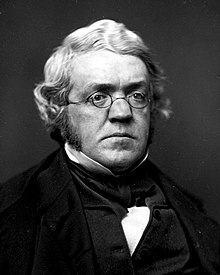
Back William Makepeace Thackeray Afrikaans وليم ثاكري Arabic وليم ثاكرى ARZ Vilyam Tekkerey Azerbaijani ویلیام تاکری AZB Уільям Мейкпіс Тэкерэй Byelorussian Ўільям Тэкерэй BE-X-OLD Уилям Мейкпийс Такъри Bulgarian উইলিয়াম ম্যাকপিস থ্যাকারি Bengali/Bangla William Makepeace Thackeray Breton
William Makepeace Thackeray | |
|---|---|
 1855 daguerreotype of William Makepeace Thackeray by Jesse Harrison Whitehurst | |
| Born | 18 July 1811 Calcutta, Bengal Presidency, British India |
| Died | 24 December 1863 (aged 52) London, England |
| Occupation |
|
| Nationality | English |
| Education | Charterhouse School |
| Alma mater | Trinity College, Cambridge |
| Period | 1829–1863 |
| Genre | Historical fiction |
| Notable works | Vanity Fair, The Luck of Barry Lyndon |
| Spouse | Isabella Gethin Shawe |
| Children | 3; including Anne and Harriet |
| Signature | |
 | |
William Makepeace Thackeray (18 July 1811 – 24 December 1863) was an English novelist and illustrator. He is known for his satirical works, particularly his 1847–1848 novel Vanity Fair, a panoramic portrait of British society, and the 1844 novel The Luck of Barry Lyndon, which was adapted for a 1975 film by Stanley Kubrick.
Thackeray was born in Calcutta, British India, and was sent to England after his father's death in 1815. He studied at various schools and briefly attended Trinity College, Cambridge, before leaving to travel Europe. Thackeray squandered much of his inheritance on gambling and unsuccessful newspapers. He turned to journalism to support his family, primarily working for Fraser's Magazine, The Times, and Punch. His wife Isabella suffered from mental illness. Thackeray gained fame with his novel Vanity Fair and produced several other notable works. He unsuccessfully ran for Parliament in 1857 and edited the Cornhill Magazine in 1860. Thackeray's health declined due to excessive eating, drinking, and lack of exercise. He died from a stroke at the age of fifty-two.
Thackeray began as a satirist and parodist, gaining popularity through works that showcased his fondness for roguish characters. Thackeray's early works were marked by savage attacks on high society, military prowess, marriage, and hypocrisy, often written under various pseudonyms. His writing career began with satirical sketches like The Yellowplush Papers. Thackeray's later novels, such as Pendennis and The Newcomes, reflected a mellowing in his tone, focusing on the coming of age of characters and critical portrayals of society. During the Victorian era, Thackeray was ranked second to Charles Dickens but is now primarily known for Vanity Fair.